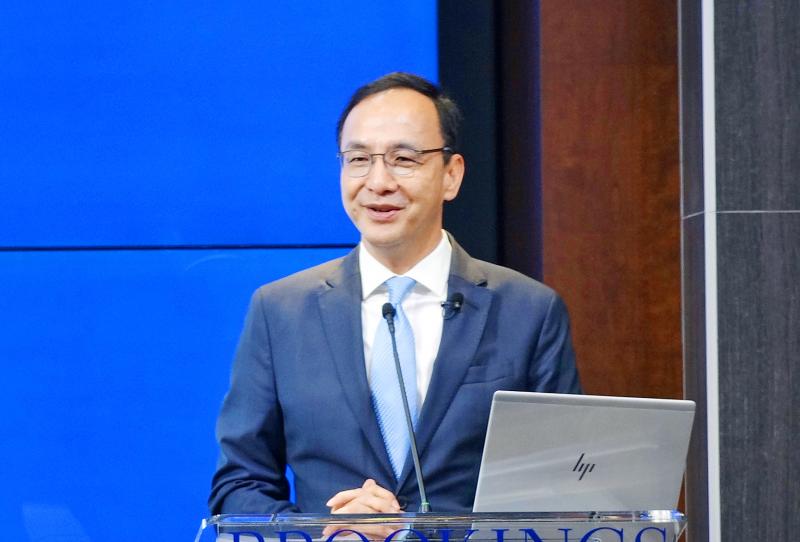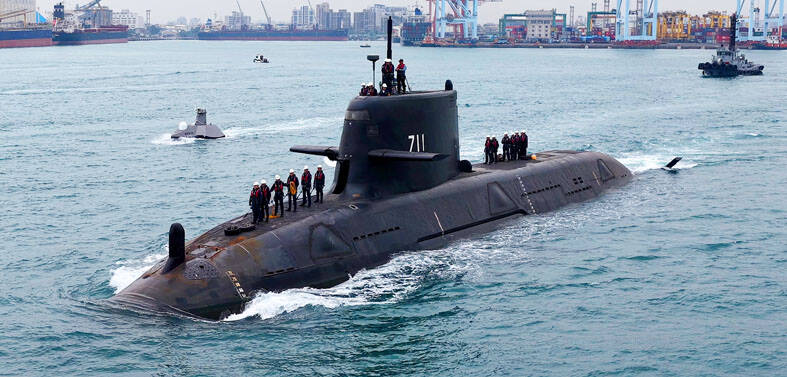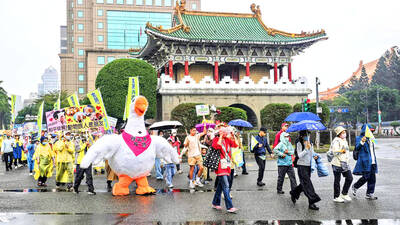Chinese Nationalist Party (KMT) Chairman Eric Chu (朱立倫) in a speech at the Washington-based Brookings Institution on Monday emphasized Taiwan’s need for enhanced defense capabilities, while adding that the party has always been pro-US.
“If you want peace, you have to prepare for war. Self-defense is No. 1 for peace and stability,” Chu said.
He offered three defense priorities for a future KMT administration: boosting asymmetric combat capabilities, arms purchases for emergency responses and raising the reserve mobilization mechanism to the Cabinet level.

Photo: CNA
It is wrong to label the KMT as being pro-China, as it has always been pro-US, he said, adding that the KMT is dedicated to defending Taiwan and to talking to China.
Taiwan could help the West better understand China and be a model for its neighbor, Chu said.
“Taiwan can have democracy; why not China some day?” he said. “We have to wait for this to happen, but we need Taiwan as a model.”
Asked by reporters about the so-called “1992 consensus,” Chu said it is a “non-consensus consensus.”
He also drew from KMT Vice Chairman Andrew Hsia’s (夏立言) comment that if all things must be clarified, non-political cross-strait interaction would suffer.
Chu’s comments were a practical response to Washington’s concerns about Taiwan’s self-defense capabilities, National Policy Foundation associate research fellow Chieh Chung (揭仲) said.
Chu’s speech was direct, which is an excellent beginning for restarting dialogue between the KMT and Washington on national defense affairs, the stated purpose of his visit, Chieh said yesterday.
Some of Chu’s views are a departure from those held by the Democratic Progressive Party, which, if pursued, could help set the tone for potential meetings between the KMT and Washington on defense issues, Chieh said.
Chu told the think tank that the KMT’s stance on 2027 and the increased risk of a military confrontation is to “prepare for combat and strive to avoid war,” Chieh said, adding that Chu dismissed certain KMT stereotypes, while clarifying that it would prioritize asymmetrical warfare capabilities upon a return to power.
Mentioning 2030, Chu showed that the KMT is aware of the potential threat of 2027, while being aware that a Chinese landing could evolve into a new threat beyond 2027, Chieh said.
Chu’s view is more prescient than some Washington analysts who overemphasize the need for certain weapons systems, Chieh said, adding that Chu’s view is becoming the sovereign national defense policy of the Republic of China.
Additional reporting by Shih Hsiao-kuang

NUMBERS IMBALANCE: More than 4 million Taiwanese have visited China this year, while only about half a million Chinese have visited here Beijing has yet to respond to Taiwan’s requests for negotiation over matters related to the recovery of cross-strait tourism, the Tourism Administration said yesterday. Taiwan’s tourism authority issued the statement after Chinese-language daily the China Times reported yesterday that the government’s policy of banning group tours to China does not stop Taiwanese from visiting the country. As of October, more than 4.2 million had traveled to China this year, exceeding last year. Beijing estimated the number of Taiwanese tourists in China could reach 4.5 million this year. By contrast, only 500,000 Chinese tourists are expected in Taiwan, the report said. The report

Temperatures are forecast to drop steadily as a continental cold air mass moves across Taiwan, with some areas also likely to see heavy rainfall, the Central Weather Administration (CWA) said. From today through early tomorrow, a cold air mass would keep temperatures low across central and northern Taiwan, and the eastern half of Taiwan proper, with isolated brief showers forecast along Keelung’s north coast, Taipei and New Taipei City’s mountainous areas and eastern Taiwan, it said. Lows of 11°C to 15°C are forecast in central and northern Taiwan, Yilan County, and the outlying Kinmen and Lienchiang (Matsu) counties, and 14°C to 17°C

STEERING FAILURE: The first boat of its class is experiencing teething issues as it readies for acceptance by the navy, according to a recent story about rudder failure The Hai Kun (海鯤), the nation’s first locally built submarine, allegedly suffered a total failure of stern hydraulic systems during the second round of sea acceptance trials on June 26, and sailors were forced to manually operate the X-rudder to turn the submarine and return to port, news Web site Mirror Daily reported yesterday. The report said that tugboats following the Hai Kun assisted the submarine in avoiding collisions with other ships due to the X-rudder malfunctioning. At the time of the report, the submarine had completed its trials and was scheduled to begin diving and surfacing tests in shallow areas. The X-rudder,

DEMAND: The government should enact regulations in line with Austria and Germany to incorporate vegan nutrition into school meals, an advocate said More than 1,000 people yesterday marched in Taipei to promote veganism, calling for legislation to incorporate vegan diets into school lunches and the national net zero emissions program. Participants gathered on Ketagalan Boulevard in front of the Presidential Office Building for the march, which was organized by the Vegan Action Network (VAN). Former ambassador to Chad Chiu Chung-jen (邱仲仁), actor Yankee Yang (楊子儀) and actress Cindy Lien (連俞涵) attended the event. VAN member Marianne Chao (趙梅君) said that the campaign aimed to urge the government to promote vegan diets across schools and government agencies via legislation and national policies, which would help build